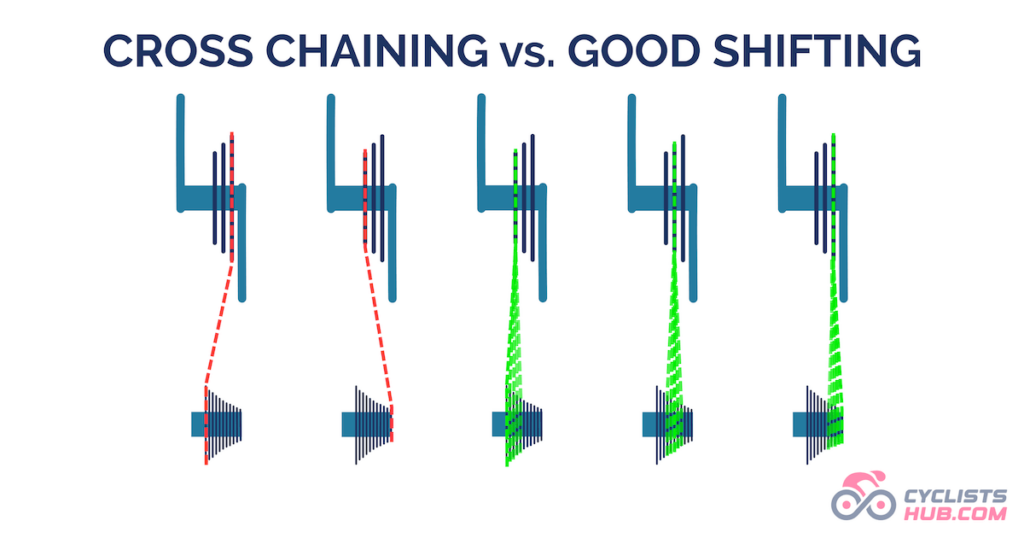Cyclists Hub is supported by its readers. We may receive a commission if you buy products using our links.All content on Cyclists Hub is written by humans, not robots. Learn More
Virtual shifting is nothing particularly new. It has been used on smart bikes for several years. However, with the introduction of the Zwift Cog, it was first featured on a smart bike trainer (Zwift Hub). Thanks to Zwift, it’s becoming more popular than ever. In this article, I explain how virtual shifting works and its advantages and disadvantages.
KEY TAKEAWAY
Virtual shifting, in combination with Zwift Cog, is a useful functionality, especially if you want to use one trainer in your home with multiple bikes that each have a different number of gears. Currently, only Zwift and ROUVY support virtual shifting. Other apps have not announced support yet. Virtual shifting also has a few more drawbacks. You can learn more about them below.
What’s Virtual Shifting and How Does It Work?
Virtual shifting replaces the traditional gear-shifting mechanism, enabling you to electronically shift gears on the bike trainer using added buttons1 instead of physically shifting them on your bike. With this system, your chain remains in the selected gear, and the trainer automatically adjusts the resistance.
It is worth noting that communication is not between the buttons and the smart trainer. The application itself takes care of the resistance calculation.

What Are the Pros and Cons of Virtual Shifting?
The following table summarizes the pros and cons of virtual shifting.
| Type of shifting | Pros | Cons |
|---|---|---|
| Virtual shifting (Zwift Cog) | • Improves compatibility with bikes that have different number of gears¹ • Eliminates cross chaining • Allows setting different gear ratios² • Quieter | • Less similar feeling to riding a bike outdoors • Slower when changing multiple gear • The position of the shifting buttons is not ideal • Not currently supported by applications other than Zwift and ROUVY |
| Traditional shifting (cassette) | • Faster when changing more gears at once • Realistic shifting • Ideal position of the shifters | • Higher risk of cross chaining • Worse compatibility with bikes that have different number of gears • Won’t allow you to change gear ratios³ • Noisier |
¹Assuming a Zwift Cog is used.
²Currently on smart bikes only
³Assuming you don’t change cassette or chainrings
Let’s now dig into the pros and cons a little deeper.
One of the biggest benefits of virtual shifting and the Zwift Cog is that you can use bikes with different numbers of gears. Swap the bikes, and the trainer will take care of the rest. Shifting gears is done with the Zwift Click buttons or the Zwift Play Controller.

The Zwift virtual shifting has a gear ratio of 0.75 to 5.49 and 24 gears. This is similar to the range of the 30T chainring and 40T cassette. In other words, you’ll have plenty of gearing for steep climbs and descents.
It also eliminates the risk of cross-chaining, as virtual shifting doesn’t physically shift gears, so the chain is in the optimal position. There is no risk of cross chaining.

However, virtual shifting has its drawbacks. Among the most significant is the slower shifting of multiple gears at once. This can be limiting when sprinting, for example, or when you need to quickly change from a heavy to a light gear.
Another disadvantage is the placement of the buttons (Zwift Click or Zwift Play). This is not quite ideal compared to classic road shifters. The electronic buttons are something extra. But maybe we will see SRAM and Shimano electronic groupsets compatible with indoor apps in the future. Zwift Ride frame solves this, as its handlebar has built-in buttons.



The last main disadvantage is the limited compatibility. Only Zwift and ROUVY currently support virtual shifting. So, you are out of luck if you want to use Kinomap, MyWhoosh, FulGaz, or other apps. This is because virtual shifting is calculated on the app, not the trainer’s side.
Conclusion
So, when buying a new bike trainer, should you buy a traditional one or one with virtual shifting? This depends on the way you will use the trainer. A smart trainer with a cassette is suitable for most, as it won’t limit you to a few apps that support virtual shifting.
On the other hand, if there are more of you in the household and you plan to use the same trainer with bikes with different gears, a trainer such as the Wahoo KICKR Zwift One will be more suitable for you.
- Using Zwift Click or Zwift Play ↩︎

